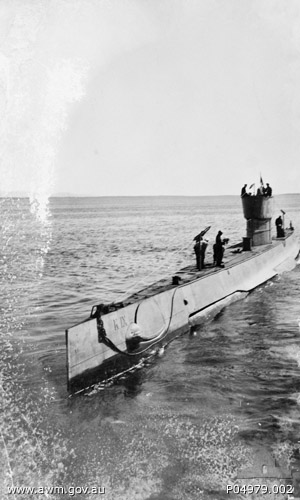
HNLMS Abraham Crijnssen is a Jan van Amstel-class minesweeper of the Royal Netherlands Navy (RNN).

HMAS Barcoo (K375/F375/A245) was a River-class frigate of the Royal Australian Navy (RAN). One of twelve frigates constructed in Australia during World War II, Barcoo, was laid down by Cockatoo Docks & Engineering Company, Sydney in 1942, and commissioned in early 1944.

HMAS Burnie (J198/B238/A112), named for the port city of Burnie, Tasmania, was one of 60 Bathurst-class corvettes constructed during World War II and one of 20 built for the Admiralty but manned by personnel of and commissioned into the Royal Australian Navy (RAN).

HMAS Colac (J242/M05), named for the town of Colac, Victoria, was one of 60 Bathurst-class corvettes constructed during World War II, and one of 36 initially manned and commissioned solely by the Royal Australian Navy (RAN).

The Bathurst-class corvettes were a class of general purpose vessels designed and built in Australia during World War II. Originally classified as minesweepers, but widely referred to as corvettes, the Bathurst-class vessels fulfilled a broad anti-submarine, anti-mine, and convoy escort role.

HMAS Kuttabul, formerly SS Kuttabul, was a Royal Australian Navy depot ship, converted from a Sydney Ferries Limited ferry.

In late May and early June 1942, during World War II, Imperial Japanese Navy submarines made a series of attacks on the Australian cities of Sydney and Newcastle. On the night of 31 May – 1 June, three Ko-hyoteki-class midget submarines, each with a two-member crew, entered Sydney Harbour, avoided the partially constructed Sydney Harbour anti-submarine boom net, and attempted to sink Allied warships. Two of the midget submarines were detected and attacked before they could engage any Allied vessels. The crew of M-14 scuttled their submarine, whilst M-21 was successfully attacked and sunk. The crew of M-21 killed themselves. These submarines were later recovered by the Allies. The third submarine attempted to torpedo the heavy cruiser USS Chicago, but instead sank the converted ferry HMAS Kuttabul, killing 21 sailors. This midget submarine's fate was unknown until 2006, when amateur scuba divers discovered the wreck off Sydney's northern beaches.

HMAS Armidale (J240), named for the then town of Armidale, New South Wales, was one of 60 Bathurst-class corvettes constructed during World War II, and one of 36 initially manned and commissioned solely by the Royal Australian Navy (RAN).

The history of the Royal Australian Navy traces the development of the Royal Australian Navy (RAN) from the colonisation of Australia by the British in 1788. Until 1859, vessels of the Royal Navy made frequent trips to the new colonies. In 1859, the Australia Squadron was formed as a separate squadron and remained in Australia until 1913. Until Federation, five of the six Australian colonies operated their own colonial naval force, which formed on 1 March 1901 the Australian Navy's (AN) Commonwealth Naval Force which received Royal patronage in July 1911 and was from that time referred to as Royal Australian Navy (RAN). On 4 October 1913 the new replacement fleet for the foundation fleet of 1901 steamed through Sydney Heads for the first time.

The Royal Australian Navy Submarine Service is the submarine element of the Royal Australian Navy. The service currently forms the Navy's Submarine Force Element Group (FEG) and consists of six Collins class submarines.

HMAS Gawler (J188/B241/A115), named for the town of Gawler, was one of 60 Bathurst-class corvettes constructed during World War II and one of 20 built for the Admiralty but manned by personnel of and commissioned into the Royal Australian Navy (RAN). The ship was laid down by BHP at its Whyalla shipyard in early 1941, launched later that year, and commissioned in 1942.
HNLMS K VIII was one of the three K VIII-class submarines of the Royal Netherlands Navy, built to serve as patrol vessel for the Dutch colonies. Launched in 1922 the boat saw service at the start of World War II, before being decommissioned in 1942.
HNLMS K XI was the first of three K XI-class submarines of the Royal Netherlands Navy, built to serve as a patrol vessel in the Dutch colonies.

HNLMS K X was one of the three K VIII-class submarines of the Royal Netherlands Navy, built to serve as a patrol vessel in the Dutch colonies.

O 24, laid down K XXIV was an O 21-class submarine of the Royal Netherlands Navy that saw service during World War II. The most famous occupant of O-24 was Piet de Jong, who was the commanding officer from 1944 until 1946 and who later became Minister of Defence in 1963 and served as Prime Minister of the Netherlands from 1967 until 1971.

K IV was a K III-class patrol submarine of the Royal Netherlands Navy. The ship was built by De Schelde shipyard in Flushing.

K XIII was a K XI class patrol submarines of the Royal Netherlands Navy. The ship was built by Fijenoord shipyard in Rotterdam.
K XII was a K XI class patrol submarines of the Royal Netherlands Navy. The ship was built by Fijenoord shipyard in Rotterdam.

K XVIII was one of five K XIV class submarines built for the Royal Netherlands Navy. She served during World War II.
HMAS Lolita (14) was formerly a luxury motor cruiser, commissioned as a channel patrol boat into and operated by the Royal Australian Navy (RAN) during World War II. She was one of thirteen similar vessels, known to Sydney siders as the 'Hollywood Fleet'.
















